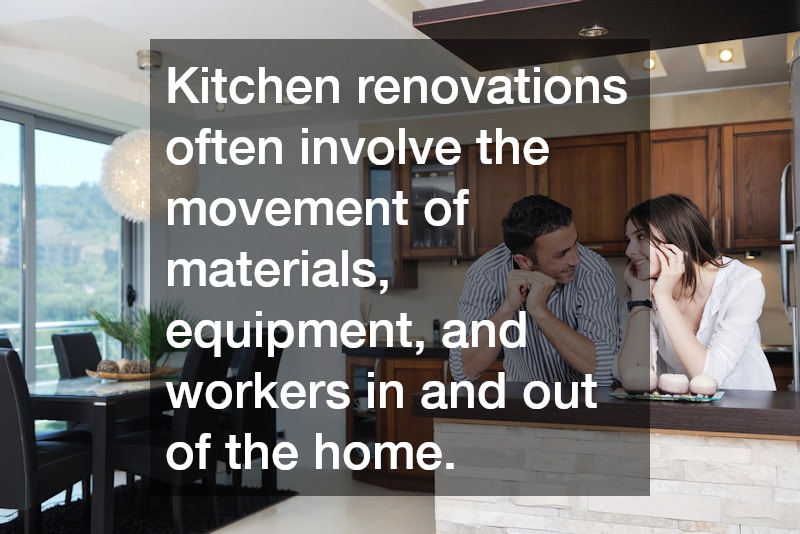A kitchen renovation is one of the most rewarding investments a homeowner can make. The kitchen isn’t just a place for cooking—it’s the heart of the home, where family and friends gather, meals are shared, and memories are made. However, transforming this vital space requires careful planning, thoughtful design, and a clear understanding of how each decision affects both function and long-term value.
From budgeting and scheduling to managing logistics and safety, a well-executed renovation combines creativity with practicality. Whether the goal is to modernize an outdated space or increase property value before a sale, each stage of planning plays a crucial role in achieving a seamless, beautiful, and functional kitchen that stands the test of time.

Setting a Realistic Budget and Timeline
Every successful renovation starts with a solid budget and a realistic schedule. Planning ahead prevents costly mistakes, unnecessary stress, and project delays. Begin by defining what the renovation must include versus what would be nice to have. This helps prioritize spending while ensuring that core upgrades—like plumbing, cabinetry, and lighting—receive the necessary investment.
Budgeting tips for homeowners:
-
Research average kitchen renovation costs in your area and add 10–15% for unexpected expenses.
-
Request multiple quotes from licensed contractors to compare pricing and inclusions.
-
Allocate funds for temporary living arrangements or dining out if your kitchen will be unusable during the remodel.
Hiring a mover can be an efficient solution during major remodels. Professionals can safely relocate kitchen furniture, appliances, and fragile décor to a storage unit or another part of the house while construction is underway. This step keeps valuable items protected and allows contractors to work efficiently without obstruction.
Time management is equally vital. Setting milestones for each phase—design, demolition, installation, and inspection—helps homeowners stay on track and avoid project fatigue.
Clearing the Space and Preparing for Construction
Before any renovation can begin, the space must be properly prepared. A clean, empty workspace minimizes hazards and ensures the contractors can start right away.
This is where cleanout services can make a significant difference. Professional cleanout crews can quickly and responsibly remove old cabinetry, outdated appliances, and years of accumulated clutter. They often handle recycling and disposal in compliance with local regulations, saving homeowners the time and hassle of multiple dump trips.
It’s also important to inspect the area for signs of pest activity before beginning construction. Partnering with a reputable animal removal service ensures that any nesting wildlife or rodents are safely relocated before demolition starts. Addressing these issues early prevents damage to wiring, insulation, or drywall, protecting both workers and your home investment.
Additionally, tree trimming around the property may be necessary to create safe access for contractors and protect exterior structures from falling branches. Properly pruned trees reduce the risk of damage during construction and allow more natural light into the workspace, creating a safer and more efficient renovation environment.
Pre-construction checklist:
-
Remove all kitchen items, including utensils, dishes, and small appliances.
-
Seal off adjacent rooms with plastic sheeting to control dust.
-
Turn off power to affected circuits before electrical work begins.
-
Label boxes and containers clearly if storing items off-site.
Taking the time to prepare the workspace thoroughly sets the stage for a smoother, more efficient renovation process.

Designing a Kitchen That Reflects Function and Personality
The design phase is where imagination meets functionality. Homeowners should think about how they use their kitchen daily—whether it’s a space for gourmet cooking, family gatherings, or entertaining guests.
A local kitchen renovation specialist can help create a design that blends practicality with personal taste. Local professionals are familiar with area trends, permitting requirements, and the types of materials that perform best in regional climates.
Key design considerations:
-
Layout: Choose from popular styles such as L-, U-, or galley layouts based on available space and workflow.
-
Lighting: Combine ambient, task, and accent lighting to make the kitchen both functional and inviting.
-
Storage: Integrate vertical shelving, pull-out drawers, and hidden cabinets to maximize organization.
-
Finishes: Use materials that complement the overall home aesthetic, from natural stone countertops to energy-efficient fixtures.
Working closely with a custom home builder can elevate the design further. Builders can integrate structural or architectural upgrades—such as open floor plans or breakfast nooks—that improve both form and value.
Managing Outdoor Access and Property Logistics
Kitchen renovations often involve the movement of materials, equipment, and workers in and out of the home. This increased traffic can take a toll on the property’s exterior.
Installing or maintaining automatic gates during the renovation can streamline access while improving safety and privacy. Contractors can easily move materials in and out without compromising security. For homes with larger lots, automatic gates also protect pets and children during periods of heavy activity.
Homeowners with mature landscaping may also need to coordinate tree removals or temporary trimming to accommodate construction vehicles or deliveries. Overgrown trees can obstruct driveways, damage power lines, or interfere with new additions like extended patios or window expansions.
Outdoor management tips:
-
Schedule tree services early to prevent delays in material delivery.
-
Keep pathways and driveways clear for workers and equipment.
-
Ensure gates are functional to maintain site security.
Planning these logistics in advance keeps the renovation site organized and minimizes disruptions to daily life.
Creating a Functional Layout That Enhances Daily Living
Beyond aesthetics, the kitchen must serve as a space that supports daily routines with ease. The layout should facilitate smooth movement between cooking, cleaning, and dining areas.
Homeowners can enhance workflow by following the classic “kitchen work triangle,” which places the sink, stove, and refrigerator within convenient proximity. Modern layouts may also include designated prep zones, breakfast bars, or hidden pantries for additional convenience.
When integrating new appliances or smart home technology, consult a certified electrician to ensure wiring and outlets meet updated codes. Small upgrades—like under-cabinet lighting or USB charging stations—can significantly boost everyday functionality.
For households with active lifestyles, creating open sightlines between the kitchen and adjacent living areas makes multitasking easier. Parents can monitor children, watch the news, or chat with guests while cooking, adding comfort and connectivity to daily routines.
Enhancing Energy Efficiency and Sustainability
Modern homeowners are increasingly prioritizing sustainability in their renovations. Energy-efficient choices not only reduce monthly utility bills but also support environmental responsibility.
Some of the most impactful upgrades include:
-
LED lighting and ENERGY STAR-certified appliances.
-
Low-flow faucets and water-saving dishwashers.
-
Proper insulation and ventilation to regulate indoor temperature.
Collaborating with eco-conscious contractors helps ensure that materials—such as flooring, countertops, and cabinetry—are responsibly sourced.
Additionally, exercise enthusiasts can enhance their overall wellness routine by placing an elliptical machine or compact home gym near the kitchen area, promoting balance between physical health and nutrition. A holistic approach to home design considers how daily habits align with comfort and sustainability.
Maintaining Structural and Mechanical Integrity
During renovations, homeowners must pay close attention to the home’s underlying systems—plumbing, electrical, and ventilation. Neglecting these areas can result in future repairs that offset the benefits of the remodel.
Scheduling inspections at key stages ensures everything runs efficiently once the renovation is complete. If any issues arise, local contractors can handle them before final installation, preventing delays and additional costs.
For older homes, consulting professionals who specialize in complex systems like manual transmission repair can offer insights into handling intricate mechanical work, similar to the precision required for updating older kitchen fixtures, piping, or ventilation systems. Their understanding of system restoration parallels how careful adjustments keep performance optimized over time.
Similarly, partnering with a reputable auto brake repair shop or mechanical specialist highlights the importance of maintenance schedules—an approach homeowners can apply to their kitchen equipment, appliances, and structural components for long-term reliability. Routine inspections, timely repairs, and professional guidance ensure that every system functions safely, efficiently, and consistently, preserving both the home’s value and the family’s comfort for years to come.
Incorporating Technology and Smart Features
Technology continues to redefine modern kitchens, offering homeowners convenience and connectivity. Smart refrigerators, touchless faucets, and app-controlled lighting are just a few examples of innovations that elevate functionality. Beyond aesthetics, these features streamline daily routines, reduce energy consumption, and provide enhanced safety measures, such as automatic water shutoff or temperature alerts.
Installing a home audio system can transform the kitchen into a vibrant space for both entertainment and family bonding. Whether listening to music during meal prep, hosting dinner parties, or enjoying a casual breakfast, integrated sound systems create an engaging atmosphere. Strategically placed speakers and wireless connectivity allow for a seamless auditory experience throughout the home, making the kitchen a central hub for both family life and social gatherings.
Consider adding voice-activated assistants or smart thermostats for additional comfort and energy efficiency. Homeowners should work with professional installers to ensure proper wiring, compatibility among devices, and adherence to safety standards. This prevents potential technical issues and maximizes the functionality of all connected devices.
Additional smart upgrade ideas:
-
Install smart sensors that monitor appliance usage and alert for maintenance needs.
-
Use automated window treatments to regulate natural light and improve energy efficiency.
-
Integrate security features like smart locks or cameras for enhanced peace of mind.
Smart kitchens not only add convenience but also appeal to tech-savvy buyers, increasing the home’s resale value. They combine practicality with entertainment, creating a multifunctional space that meets the demands of modern living while enhancing long-term property worth.
Coordinating Final Touches and Inspections
As the renovation nears completion, attention to detail becomes crucial. Final inspections ensure every component meets quality and safety standards before daily use resumes. This stage not only validates the craftsmanship but also identifies any minor issues that may require immediate correction, preventing long-term problems or costly fixes.
Checklist for final stages:
-
Test all electrical outlets, plumbing fixtures, and appliances.
-
Inspect cabinetry alignment and hardware installation.
-
Verify paint, flooring, and backsplash finishes for consistency.
-
Conduct a deep cleaning before moving items back in.
-
Ensure ventilation, lighting, and safety devices are fully operational.
-
Check that countertops, sinks, and appliances are properly sealed and functional.
This is also the ideal time to engage local auto body repair services or similar local trade professionals who understand precision craftsmanship. Their approach to detail mirrors the careful evaluation homeowners should apply during the inspection phase—ensuring every fixture, seam, and finish aligns perfectly.
Working with a nearby auto body center or equivalent service provider highlights the importance of community-based expertise. Local professionals often bring a higher level of accountability and pride in workmanship, qualities that resonate with successful home renovation outcomes. Collaborating with trusted local specialists also provides peace of mind, as homeowners can rely on rapid responses to any issues and benefit from recommendations rooted in long-term experience. By incorporating these final checks and professional insights, the kitchen renovation concludes efficiently, leaving a space that is both functional and visually flawless.
Preparing for Emergencies and Post-Project Care
Even after completion, maintenance remains an ongoing responsibility. Establishing preventive care routines keeps the kitchen safe, efficient, and beautiful for years to come. Consistent upkeep not only extends the lifespan of appliances and finishes but also protects the investment homeowners have made.
Homeowners should treat their kitchen like any major asset—requiring scheduled maintenance, inspections, and documentation. Regularly checking plumbing connections, caulking, and grout prevents small leaks from becoming major repairs. Similarly, updating safety devices such as smoke detectors, fire extinguishers, and carbon monoxide alarms ensures the space remains secure for all occupants.
For instance, homeowners who experience sudden structural issues—like plumbing leaks or roof damage—can relate to the importance of rapid car recovery after an accident. In both cases, immediate professional response prevents further harm and restores functionality quickly.
Similarly, a car accident attorney ensures that damage assessments and claims are handled efficiently—an analogy homeowners can apply when dealing with insurance or warranty claims for renovation-related damages. Understanding legal and financial protections helps preserve long-term value and peace of mind.
Post-renovation upkeep tips include:
-
Conducting quarterly inspections for leaks or structural wear.
-
Maintaining appliance warranties and service records.
-
Keeping renovation receipts for insurance and resale documentation.
-
Cleaning vents and filters regularly to maintain indoor air quality.
-
Updating lighting fixtures and hardware periodically for energy efficiency.
-
Scheduling annual professional cleanings for flooring, countertops, and ducts.
A thoughtfully planned kitchen renovation does more than enhance a home’s appearance—it enriches daily living, promotes sustainability, and increases property value. When executed with patience and attention to detail, the process transforms a simple cooking space into the true heart of the home.
By coordinating expert services, planning logistics carefully, and integrating modern design elements, homeowners create a lasting balance of beauty and functionality. Beyond the cabinetry and countertops, the best renovations reflect how families live, grow, and connect.
A kitchen designed with purpose and care becomes more than a room—it becomes a reflection of the people who call the house their home.


